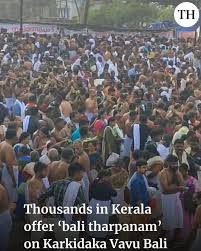Understanding Karkidaka Vavu: Significance and Traditions

Introduction
Karkidaka Vavu, observed in the month of Karkidakam (July-August), holds immense importance in the cultural and spiritual calendar of Kerala. This day is especially significant for honoring deceased ancestors, reflecting deep-rooted traditions that connect the living with their forebears. The festival, which falls on the new moon day (Amavasya) of Karkidakam, is an occasion for family gatherings and religious observances, making it a time of reflection and gratitude.
Significance of Karkidaka Vavu
Karkidaka Vavu is primarily dedicated to the ritual of ‘Pithru Tharpanam’ or offering food and prayers to deceased ancestors. According to Hindu beliefs, performing these rituals ensures peace for the souls in the afterlife and helps in the wellbeing of the living. Families in Kerala prepare elaborate meals, including dishes made of rice, lentils, and other traditional foods, which are offered to their ancestors during this solemn occasion. The observance of this day is not just a personal affair but a communal one, emphasizing the collective memory of families and their heritage.
Customs and Rituals
The day starts early in the morning, with families gathering to perform various rituals at home or riversides. The most common practice is to use a small open area where offerings are made. A few key customs include: 1. Preparation of Naivedyam: This involves cooking a variety of food items, symbolizing nourishment for the departed souls. 2. Puja and rituals: The head of the family generally conducts the prayers, invoking blessings for the ancestors. 3. Offering food to crows: Crows are considered messengers of the spirit world in Hindu belief, and feeding them is believed to ensure that the offerings reach those who have passed on.
Modern-day Observance
In contemporary times, while many traditional practices remain, Karkidaka Vavu has seen the adaptation of rituals to fit modern lifestyles. With urban migration and busy schedules, some individuals opt for simpler versions of the rituals or participate in community gatherings at temples. Despite these changes, the essence of honoring ancestors remains unchanged, signifying continuity amid change.
Conclusion
Karkidaka Vavu serves as a reminder of the vibrant cultural heritage of Kerala, reinforcing the importance of familial bonds and ancestral remembrance. As more people globally recognize the significance of roots and heritage, this day continues to evolve while retaining its fundamental purpose. Observing Karkidaka Vavu not only strengthens personal connections but also enhances community ties, making it a vital aspect of Kerala’s socio-cultural fabric.









